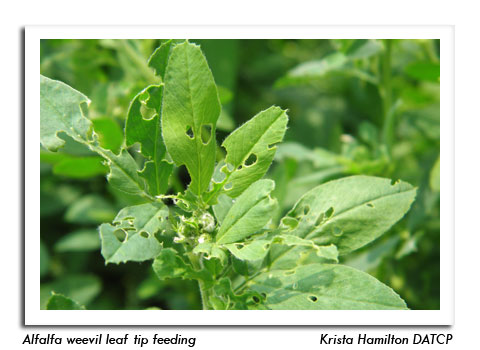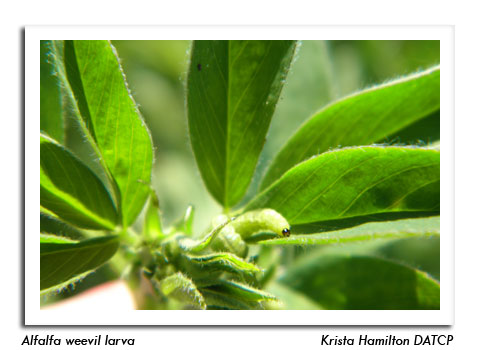
 |
|
|
Forages & Grains
Volume 57 Number 6 Date 05/17/2012 ALFALFA WEEVIL - Surveyed fields in Dane, Juneau, Monroe and Sauk counties contained populations of 1-16 first- to third-instar larvae per sweep, with an average of 4 per sweep. Larval infestations of consequence were confined mostly to northwestern Dane County where leaf tip damage averaged 40%, but ranged as high as 80%. Lower numbers of 0.3-1.1 per sweep were observed in Brown, Calumet, Manitowoc, Outagamie and Washington counties. Management plans at this time should include harvesting fields as soon as possible and monitoring new growth of the second crop for possible treatment needs. POTATO LEAFHOPPER - Numbers are escalating in alfalfa fields across the state. Migrant adult populations are still below threshold levels at 1-4 per 10 sweeps, but reproduction was noted as early as May 2 this season and warmer temperatures could cause rapid succession of generations by early June. Second growth alfalfa is particularly susceptible to leafhopper feeding and should be closely monitored. PEA APHID - Aphids are abundant in field collections in southern and central fields where they occasionally average 16 per sweep. The average is about 6-7 per sweep. Counts of this level are considered non-economic in alfalfa, but pea aphid populations can escalate rapidly when their natural enemies are disrupted by alfalfa weevil insecticide sprays. Harvesting fields on time rather than using insecticidal control is important for preserving natural enemies. PLANT BUG - Adults and nymphs were found in low numbers of 0.1-1.2 per sweeps again this week. Nymphs were noted in 21 of 39 fields (54%) checked in southern and central counties. MEADOW SPITTLEBUG - Spittle masses are increasing in size and most nymphs are currently ¼ to ½ grown. The highest population encountered was 22 per 50 stems near Reedsburg in Sauk County, which is moderate in comparison to the economic threshold of 1 nymph per stem. Most surveyed fields had significantly fewer spittlebugs. --Krista Hamilton, DATCP Entomologist 





|
|
|